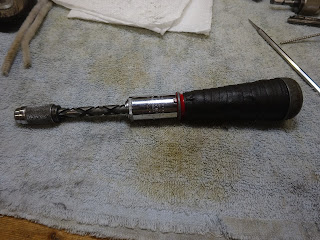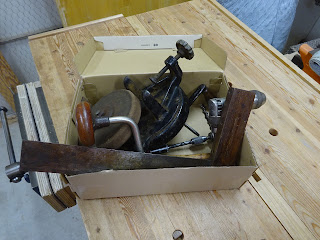This post is about the hand crank grinder found recently at an estate sale. There was no maker name - that always bugs me. Seems to me that if they were proud of what they make, they'd put a name on it. I realize it could be made by a known maker for a retail outlet or hardware store, but still, give me a name!
 |
| Looks reasonable enough |
It came with a wheel of unknown origin that is 1" thick and has a 1" bore. The bore is lined with metal (or pewter?) and doesn't seem to have been carefully made. The wheel is currently about 5 3/8" diameter with heavily rounded corners. There is no indication of a maker of the wheel.
 |
| I think some wheels are directional, so I marked the outside face. You can see a lot of gunk caked on the sides of the wheel. |
This grinder can handle a 6" wheel. It has a 1" arbor (right word?) for the wheel to sit on, but that part is only about 5/16" long.
 |
| Pointing to the part of the arbor on which the wheel is mounted |
The threaded end of the arbor is RH thread! I thought they were typically LH thread so that the action of using the grinder won't loosen the wheel. Heck, maybe this one was made for left handed users. The tool rest can move to a second location that would make this possible.
You can see the tool rest in two of the above pictures. It's a simple "L" bracket with a slot on one arm for adjustability. It is fastened to the grinder with a slotted screw and a square nut.
 |
| The tool rest |
The crank handle is secured with a hex nut. But when the nut is removed, I still can't remove the handle! Sometimes there is also a set screw holding the handle on, but it doesn't appear to have one.
 |
| The handle and its nut |
There are two oil ports that are stopped up with short screws that have knurled heads for easy opening. The upper one allows oiling of the small gear wheel and the lower port oils the shaft that the handle turns.
 |
| The oil ports and screws |
The inner works are accessed by removing four screws on the clamp side of the body.
 |
| Pointing to one of the four screws |
 |
| The inner works |
 |
| Close-up of the large gear |
Best as I could count, there are about 156 teeth on this gear and none are broken. But the inside of this grinder was dry as a bone! I mean there was virtually no evidence that there was ever any grease or oil in there.
I couldn't access the small gear, but I tried to count teeth through a small slit. There might be 10-12 teeth, but I could easily be mistaken. What I do know is that for every turn of the handle, the grinding wheel turns about 13 times - the math works out to having 12 teeth on the small gear. This is the same turn ratio as for my other hand grinder.
 |
| Peering through an opening, you can see a bit of the small gear. |
The big difference with this grinder and my other one is that the gear teeth are straight across - that is, they run 90° to the tangent line of the gear.
 |
| Gear configuration of my first grinder where teeth are angled relative to the tangent |
When the grinder was reassembled and oiled, it was still a little rough. But I could tell that there was a little play in the location of the large gear. With the gear cover screws still undone, the large gear meshed better with the small gear if I physically moved it closer to the small gear. So I was able to tighten the two upper screws with the gear in better position and then tighten the lower two screws and this seems to have helped. The grinder turns much better now - not as smooth as I would like, but better. Maybe the other grinder, having the angled gear teeth, is just plain smoother.
I noticed some wobble in the wheel when reinstalled. The wheel wobbled both side to side and front to back (not concentric with the arbor). The side to side wobble can be fixed with paper shims between the wheel and the flange.
 |
| Four thicknesses of paper at upper left, two at upper right took care of side to side wobble |
 |
| Another shim (piece of soda can) was placed between the arbor and wheel to fix the front to back wobble |
The above fixes were done with a different wheel than the one that came with this grinder. I might have to use a different shim layout if I switch wheels.
Finally, If I do use the wheel that came with this grinder, I needed to clean it up. I put it on the stove in an old frying pan filled with water and boiled it for about a half hour to an hour. This cleaned a lot of the crap off the sides of the wheel. I then used a stiff wire brush to continue the cleaning and now it is almost like new.
 |
| The wheel as found ... |
 |
| ... and after being cleaned up |
So, now I have a second grinder. It'll really come in handy when a different type of wheel is called for - no more switching.































